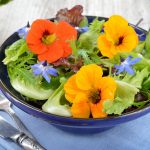- Edible flowers not only add colour and flavour to a dish, they also have some intriguing health benefits too.
Edible flowers have been eaten for centuries in countries like China and have long been part of the culinary arts. Where they are used, they are an essential ingredient in many recipes, often help season a dish and be used as a colourful garnish. The stars of the culinary world along with foragers now advocate their presence as part of a more wholesome approach to recipes. As well as the edible flowers and petals, we also find botanical extracts of the same plant being infused into a dish to enhance the sweet taste and pep up the aromaticity of the dish. It’s a real eye-opener for any product developer aiming to add something interesting to their products.
Violas, pansies and nasturtiums are extremely popular because of their vibrant colours. One of the most interesting petals are those of the day lily which was discussed a number of years ago at the IFT meeting in Las Vegas, NV as part of a research project at Mississippi State University in the US (Pollard et al., 2004).
Many types of tea also exploit petals. Has anyone tried rose petal tea ?
Chinese researchers found common edible flowers collected in Chinese gardens were rich in phenolics and had an excellent antioxidant capacity. The phenolics in some flowers are correlated with anti-inflammatory activity which led to a reduced risk of cardiovascular disease and certain cancers.
Flowers should be added to food to not only enhance their beauty but also improve the healthiness. There is renewed interest in other aspects associated with flowers such as its anti-tumor, anti-inflammation and anti-aging activity.
One of the issues to be dealt with if edible flowers are to be used more frequently, is improving their shelf-life. The current method is to use air freight but now atmospheric packaging may take over. The gas, 1-methylcyclopropene (1-MCP) is used to help retain the freshness of the flower petals (Luo et al., 2012).
References
Luo. Y., Kou, L., Turner, E. (2012) 230-19 Extending the Shelf Life of Edible Flowers with Controlled Release of 1-Methylcyclopropene and Modified Atmosphere Packaging. 2012 IFT Annual Meeting, June 25-28, Las Vegas NV USA.
Pollard, A.N., Coggins, P.C., Coker, C.E., Fain, G.B., Knight, P.R. (2004) 49D-3 Sensory evaluation of edible daylilies (Hemerocallis sp.). 2004 IFT Annual Mtg., July 12-16, Las Vegas, NV. USA

Leave a Reply